6 Reasons Modern Movie CGI Looks Surprisingly Cheap
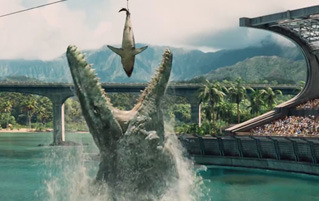
It's been over two decades since CGI came careening through the silver screen to murder cops, lawyers, and other civil servants in Terminator 2 and Jurassic Park. Since then, both films have been praised for their inexplicably realistic effects, even though both movies have birthed a handful of sequels with much more powerful special effects technology at their disposal. Despite the fact that Terminator Genisys and Jurassic World are brimming with CGI that is objectively more realistic than the original films from the early '90s, so many people (myself included) seem to agree that the effects in the originals look better than the slick computer graphics of the modern sequels.
Why do a bunch of us find the photorealistic carnage of the Genisys and Jurassic World trailers so woefully unappealing? The answer isn't dumb nostalgia (well, not just dumb nostalgia) but rather that the best CGI in the world might as well be The Scorpion King if the filmmakers fail to realize a handful of fundamental things about special effects, such as ...
Lack Of Visual Restraint Makes Gravity Act Like A Cartoon

There might be a time when CGI finally traverses the uncanny valley and becomes indistinguishable from the real world. Only none of that will matter as long as filmmakers continue to apply physics with a spongy fist. Even Viggo Mortensen said that as Lord Of The Rings progressed, Peter Jackson lost more and more restraint, like a fat kid at a rehab clinic because he's addicted to heroin, you insensitive monster. And speaking of insensitive monsters -- here's Orlando Bloom somehow piercing the hide of a titan elephant before sliding down its trunk like Fred Flintstone clocking out for the day:

He just indifferently jumps from the final breath of a dying war beast like he's stepping out of a Geo Prizm. Even if the CGI was spotless, the audience has no frame of reference for what a grown man gleaming the cube off of a six-tusked safari animal looks like. So, in the end, this physics-defying stunt just turns Legolas into an immortal Looney Tunes character. The inexplicable Hobbit trilogy ramps this up even more when they have him pull an actual Wile E. Coyote moment in the final film:
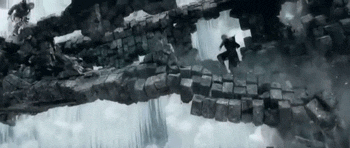
It's hard to blame someone for wanting to make something look as awesome as they imagine, but sometimes having that "sky's the limit" freedom means knowing when to keep it grounded. It's advice they needed to heed in Terminator Genisys, when the T-1000 slices off its own arm to then use as a javelin:
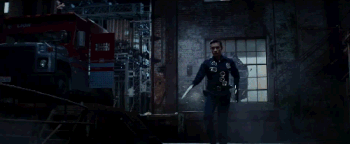
What seems like a fun little CGI flourish ends up opening a world of impossible character motivation and baffling physics. Why would a thoughtless killing machine waste precious murder-seconds dramatically lopping off his own spike and flipping it into the air like a futuristic baton twirler? How did it even manage to perfectly spin its amputated dagger arm like that? Is it wise for a liquid-metal robot to willingly javelin his body parts? What if he loses the piece? Won't he keep getting smaller with every new one he loses? The director probably didn't ask any of these questions, because he just wanted this shot to look cool. It's the exact same problem later in the trailer, when the T-800 goes tumbling into traffic:
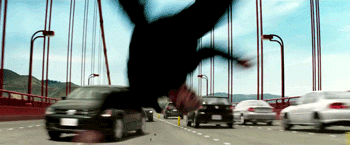
It took me forever to figure out why this shot looked so wrong, until realizing that the one-ton robot flying down the highway somehow manages to lightly flip and bounce like a two-pound puppy. The obvious explanation is that the director needed Arnold to end with his face through the windshield for the hilarious little gag that happens next, and accomplished this by throwing out everything we know about gravity and inertia in the process. It's yet another case of an object or person going where the director needed it to go, instead of where it naturally would. And while many movies these days actually hire physicists to tell them if they're punching Isaac Newton in the taint, that advice is meaningless if you're using CGI to pull off an entire stunt instead of trying to perform it in the real world.
It's like they're challenging us to think of the movie as anything but a cartoon. Especially now that every film is colored like one ...
Color Grading Makes Everything Look Like A Fantasy

Movies like Transformers and The Hunger Games are so aggressively teal and orange that they look like big-budget adaptations of a Spencer Gifts blacklight poster. As we've explained before, the reason for this is that those two colors are on opposite sides of the color wheel, and as such are immediately pleasing to human eyes. Since human skin best resembles orange more than anything else on that wheel, color graders had an easy starting point to completely ruin every film they work on.
If you're wondering what I mean by "color grading," take a look at this comparison between two similar scenes in Jurassic World and Jurassic Park:
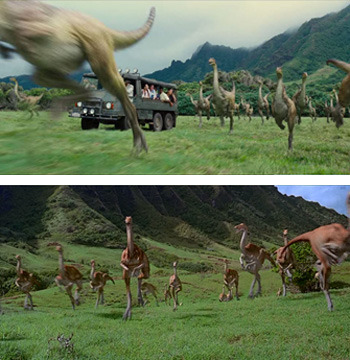
Notice how everything in Jurassic World has a foggy layer of desaturated blue over it? It's subtle, and we've gotten used to it because every movie does it now, so just for shits, I swapped the two styles for comparison ...
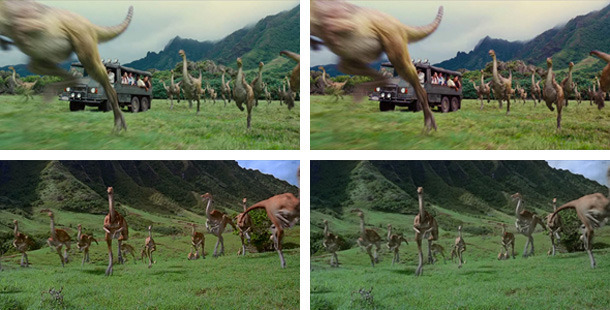
Then, because compulsion is a disease, I started removing the color grading from every shot in the trailer:
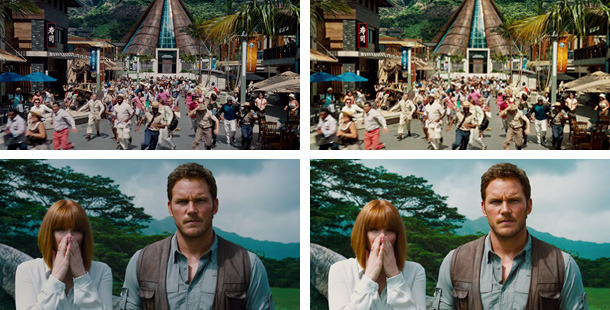
For the life of my family, I can't fucking figure out why anyone would want to watch a movie that's filtered to look like someone refusing to remove their Ray-Bans. The reason you don't see this in Jurassic Park or other '90s movies is because it hadn't been invented yet. Color grading was made popular by the Coen brothers after CGI became the go-to special effect, when they decided to use color grading to make O Brother, Where Art Thou? look like an old sepia-toned photograph. But their point was to detract realism from the finished product, whereas Jurassic Park was (originally) about creating larger-than-life creatures in a real-world setting.
This is why the effects in The Avengers and Dawn Of The Planet Of The Apes look so darn good in comparison. Along with dumping shit-tons of money into the CGI, those movies didn't wash everything over with color grading to make it look like Middle-goddamn-earth. It's the actual world, with actual earth tones. Compare that to Godzilla, which looks beautiful but appears to take place in a gritty Pleasantville covered in volcano ash:
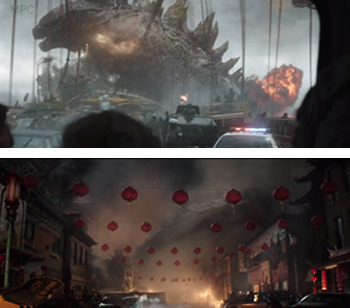
CGI Was Originally Used As A Last Resort

Except for four minutes of screen time, every special effect you see in Jurassic Park was either an animatronic or Jeff Goldblum's enchanting chest hair. And while it might have just been a budget issue or the technological limitations of CGI at the time, the system worked, goddammit. Look at the scene in The Lost World where the T-rex romps about San Diego like a drunk horse:
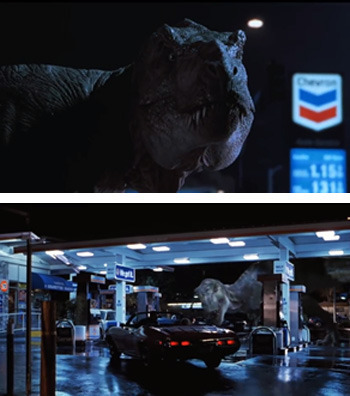
The moment we need to see a close-up is when they switch to a robot, even though it in no way interacts with the surrounding environment. This is something the filmmakers went out of their way to do even though both the T-rex animatronics were such fatties that they actually built the sets around them instead of trucking them from place to place.
And that's the thing about animatronics: Even though they're cheaper to make, they're really hard to use. It's basically a foam condom stuck over a Truckasaurus skeleton trying to emote, and the process eats into the workday faster than a modular wall and Internet pornography. But the result is an in-camera lighting reference for the digital artists and close-up shots that don't look like the movie Spawn. The only animatronic we've seen so far in Jurassic World has been obscured by leaves like they are embarrassed that it's even in the film. Meanwhile, it appears that Terminator Genisys has completely forgotten that, despite ushering in the age of CGI, Terminator 2 was like 80 percent surprised-face Robert Patrick puppets.
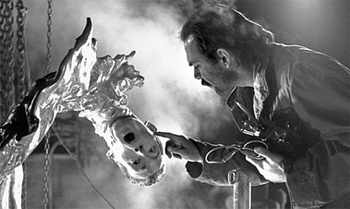
Shit, sons -- even Jurassic Park III knew to rely on head-to-toe animatronic raptors, even though that meant having one talk to Sam Neill like the goddamn Sinclair family.
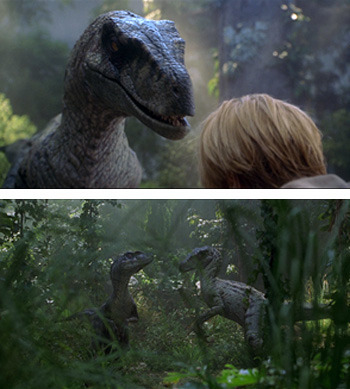
Meanwhile, in the Jurassic World trailer, every single dinosaur is CGI, no matter how close we are to them. When Chris Pratt is interacting with three Velociraptors that are right in front of his face, they might as well be cartoons, because they're right next to a living, breathing person constantly reminding us all what a living, breathing being actually looks like:
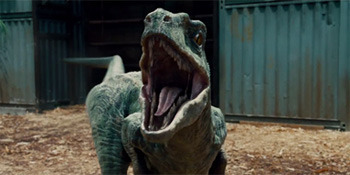
Compare that to the "clever girl" scene from the original Jurassic Park, which was basically just Stan Winston throwing a robot at a dude.
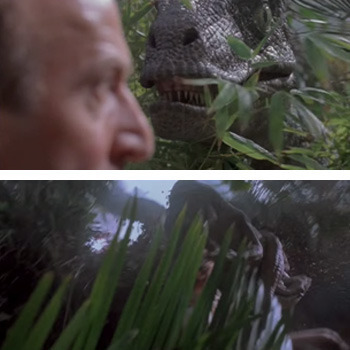
That's always going to look more convincing, because we know that robot is physically there, biting Muldoon's head. But let's say Jurassic World does have amazing animatronics to match the CGI. They also better know how to film them, because ...

Most Films Forget That A Camera Needs To Physically Exist

I'm not sure when, but somewhere down the line directors forgot that movies are still supposed to take place in real life, and they turned the camera into a coke-fueled Lakitu from Super Mario 64, just zooming around wherever the fuck it feels like. The audience needs the camera to physically occupy some kind of actual space for us to maintain a frame of reference, or else, once again, everything just looks like a freaking cartoon. For example, take a look at this scene from The A-Team, even though I'm like 70 percent certain that The A-Team was just a practical joke everyone played on Liam Neeson for his birthday:
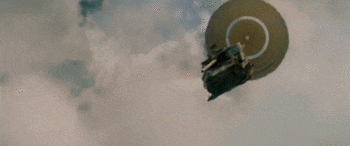
Soak up that Merrie Melodies, dick-slapping nonsense. As Furious 7 so elegantly demonstrated, we love to see fancy vehicles plummet from the sky like God's forsaken Hot Wheels -- only Furious 7 knew that we need to see that shit for real in order for it to have any kind of effect. Not only did The A-Team use CGI to phone in the madness, it made sure the cinematography was so cartoony that even people with catastrophic head trauma couldn't possibly mistake it for being real.
Then, there's the raptor chase scene from Jurassic Boogaloo, which has the camera zipping around like it's in an XFL game:
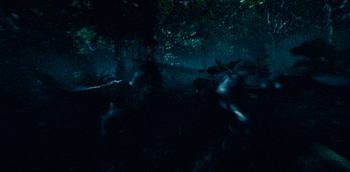
There's no edge to shooting Velociraptors like a pod race. It doesn't serve any purpose beside making me disappointed in creatures I used to pretend to be when I was 10 and sometimes at 30. This is one of many situations where having a camera that can pass through any physical object on-screen detracts from anything on-screen having any kind of presence -- it's just another reminder that what you're seeing isn't real, like that cavernous goblin-shanty from The Hobbit:
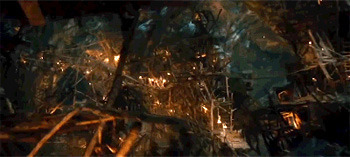
By sweeping the camera hundreds of feet through the environment, everything comes off like a model train set with tiny people composited in. The irony is that old-school miniatures were shot in a way to avoid looking tiny, something digital artists have completely forgotten about -- especially in Jurassic World, it seems:
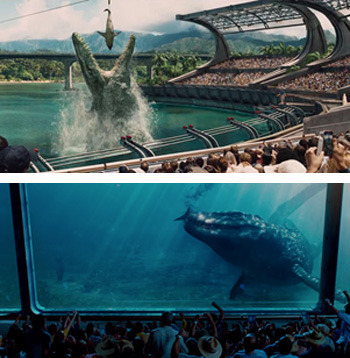
In these cases it's not that the CGI is undetailed or shitty, but rather that it's all-encompassing. The creatures aren't bursting into the real world because there's no real world to penetrate. Instead they shot some extras over a green screen and stuck them at the bottom like a particularly bad episode of Mystery Science Theater. And as directors opt for more and more digital sets, suddenly every movie looks like regular people inserted into a computer-generated cartoon, instead of CGI elements dropped into a real world. Even Jurassic Park III knew that when you're putting a digital creature into a real environment, you don't just say "fuck it" and make everything CGI. And seriously -- how many times do I have to use Jurassic Park III as a positive example? That entire clown show of a movie was incited by a parasailing accident.
Modern Movies Forget We Can Tell When Something Looks Fake

I mentioned the uncanny valley earlier -- a term used by scientists and artists to describe the psychological gap between seeing an actual, living creature and eerie human facsimiles, like Japanese robots or Willem Dafoe. We've recently gotten around this with films like Dawn Of The Planet Of The Apes -- but only through painstaking research into getting every little detail right (they even consulted an eye surgeon to figure out the exact amount of moisture to apply to the eyes of their CGI monkeys). The point is, getting past our natural instinct to fear things that look almost human but not quite is one of the hardest things an effects company can do, and it often results in big rubber men that invoke laughter over awe.
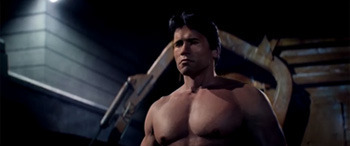
However, it would be unfair to say that the Terminator series never made a giant rubber Arnold before:
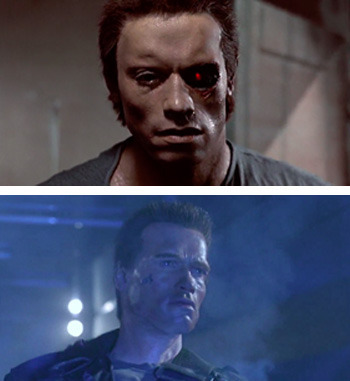
But here's the difference: Unlike Genisys, the first two Terminators seem to know that their rubber Arnolds didn't look convincing, because they used them only for very quick cuts. Hell, even McG's Terminator Salvation immediately hid their CGI Schwarzenegger with a purifying wave of cleansing fire:
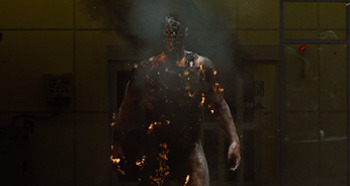
While I haven't seen Terminator Genisys yet, it appears to think that its terrible CGI Arnold double is awesome enough to prominently feature it in the trailer. There's a lack of self-awareness to the fakery.
Now replace Schwarzenegger with a hulking CGI dinosaur (shouldn't be hard) and you see why people get so mad at Jurassic World. It's not that the original Jurassic Park looks better because the CGI is better, but rather that the original film knew to hide its effects. With the exception of the extremely datedBrachiosaurus scene, most of the effects in Jurassic Park are hidden by rain and darkness.
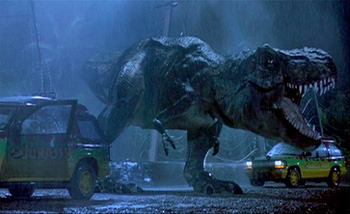
Jurassic World, on the other hand, sticks the digital puppets right in our faces like it's a banana cream pie filled with teeth:
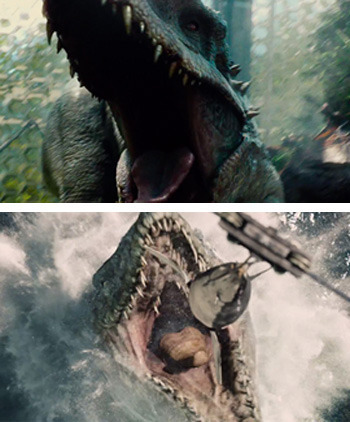
They're literally shoving us down the CGI's throat as if to say "HEY LOOK! LOOK AT THIS!" so that we can't help but point out any and all imperfections. And since not even the freaking environment around those dinosaurs is real, it's comically easy for people to notice that the effects don't look right. I mean ... they couldn't spring an extra day to shoot real water? Even Lake Placid did that:
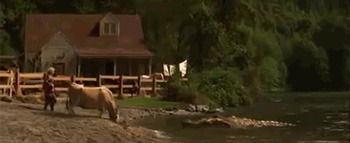
Yeah ... remember that piece of shit? The late 1990s effects of a horrifically bad giant crocodile movie should have the lasting power of a snowball in my pants -- and yet even this piece of hot garbage had the modesty to quickly cut away from what little CGI they used. And considering that it's not inexplicably tinted orange and blue, takes place in a real environment with real splashing water, and is aware of its visual limitations -- I actually prefer this shot to the Jurassic World orgy of Mosasaurus eating a shark, if only because it understood that the presentation of the effect is just as important as the effect itself.
Big Effects Sequences Are Supposed To Be Treated With Awe

I didn't care for the new, ultra-serious take on the laser-breathing dinosaur we normally call Godzilla. But, to his credit, director Gareth Edwards clearly knew how to present larger-than-life monsters as having the gravity and consequence that 100-foot sea beasts trying to find a quiet place to bump nasties would have:
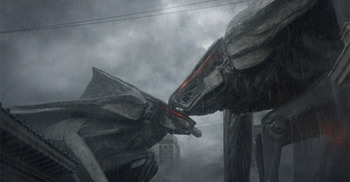
I get why people liked this film, even though it's not what I personally wanted from a Godzilla movie -- which until now was always about stupidly in-your-face, unobscured monster-on-monster violence. That said, Edwards' sense of buildup and dread is exactly what should have been in the new Jurassic World -- a film trying to follow up a classic prehistoric monster romp with only 14 minutes of actual romping.
Since having lumbering dinosaurs fighting world-fucking aliens inside a giant robot head has become so stupidly achievable, it's really easy for movies to forget how terror-shit inducing those things would be in real life. And since we have a tendency to constantly shorthand pop culture staples, it's only natural to skip over the awe part of a special effect. The time it takes for Optimus Prime to transform for the first time in each Transformers film goes from 40 seconds in the first movie, to 10 seconds in the second, to five seconds in the third.
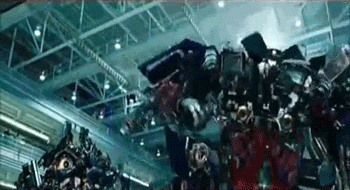
By the new one, it's easy to completely forget the spatial absurdity and scale of watching a bright red semi explode into a giant bipedal robot. We just sort of gloss over this mind-bending space colossus' shapeshifting dance until the action is reduced to a flurry of colors narrated by racist catchphrases.
The original Jurassic Park spent minutes on the Tyrannosaurus' approach. When we finally see it, we spend another several minutes on the thunderous horror of a dinosaur tearing a jeep apart as it frantically tries to eat all of the characters on-screen. The Lost World repeated this in the scene where the Tyrannosaurs knock Jeff Goldblum's trailer off a cliff, and even dumb ol' Jurassic Park III spent a lot of time on showing us exactly how much of an airplane's ass a giant dinosaur would kick (answer: all of it). Now look at this ungodly shit:
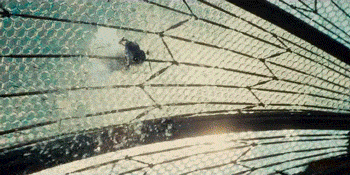
Sure, that looks pretty awesome, but destruction on that scale should blow our fucking minds. The response to dinosaurs wrecking a helicopter should be nothing short of paralysis, but this scene has no sense of gravity or consequence. There's no scale to it. There's even going to be a scene where (minor spoilers) a Pteranodon picks up a woman and literally drops her into the mouth of the Mosasaurus. It doesn't matter how real the CGI looks, because that scene belongs in a fucking Sharknado movie. It's an absurd cartoon orgy.
And so that's why some people are saying that the new Jurassic World "looks fake": The CGI is powerful, but the people who made it clearly don't have enough respect for that power. I know I'm just quoting Malcolm at this point ... but shit. They really were so preoccupied with whether or not they could have 88 dinosaurs throwing exploding helicopters at each other that they didn't stop to think if they should.
Dave can be found lurking aimlessly on Twitter if you're so inclined to say hello.
Also check out 7 Movie Special Effects You Won't Believe Aren't Computers and 5 'Jurassic Park' Plot Holes With Horrifying Implications.